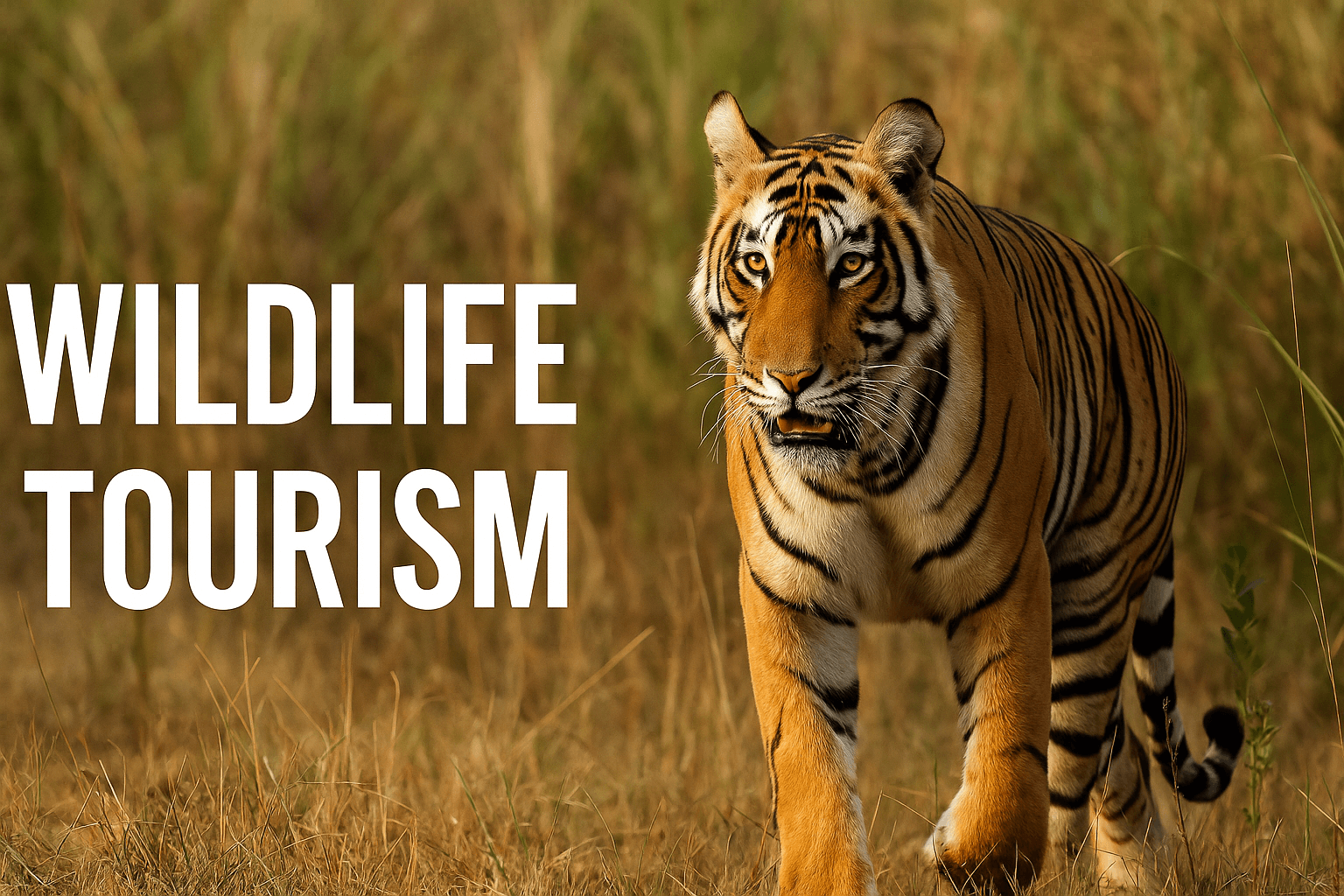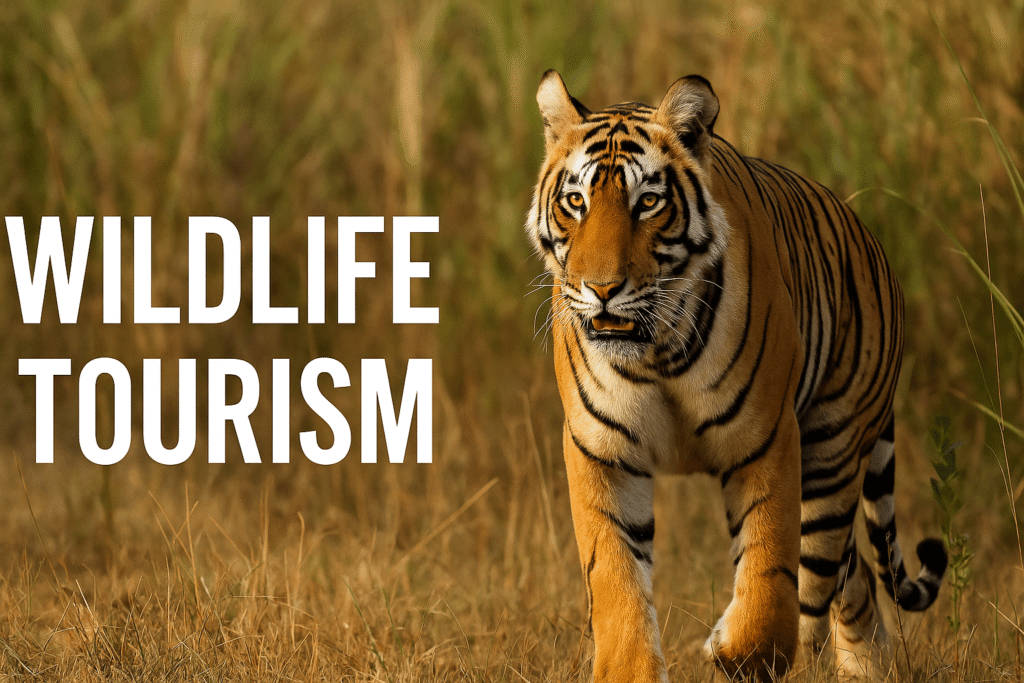Now Reading: Wildlife Tourism 2025: Explore India’s Best Nature Escapes
- 01
Wildlife Tourism 2025: Explore India’s Best Nature Escapes
Wildlife Tourism 2025: Explore India’s Best Nature Escapes

Wildlife tourism offers thrilling encounters with nature, allowing travelers to witness majestic creatures in their natural habitat—something far more powerful and humbling than seeing animals behind cages. Whether it’s tracking the elusive Bengal tiger through the dense jungles of Madhya Pradesh, listening to the haunting call of a wolf in Ladakh, or watching elephants bathe in Kerala’s backwaters, every experience is raw, real, and unforgettable.
This form of tourism isn’t just about adventure—it’s about appreciation. It cultivates a deep respect for biodiversity and helps raise awareness about endangered species and fragile ecosystems. As global interest in sustainable travel grows, wildlife tourism in India has emerged as a top choice for eco-conscious explorers.
In this blog, we’ll guide you through some of the best destinations for wildlife tourism in India, provide essential tips on how to explore responsibly, and help you make choices that benefit both the environment and local communities. Ready to take the wild route?
Table of Contents
What Makes Wildlife Tourism So Captivating?
Have you ever dreamt of seeing a tiger in the wild or hearing the call of a howling wolf deep in the forest? Wildlife tourism is more than just a travel trend—it’s an immersive experience that brings people closer to nature’s most magnificent creatures. This form of tourism not only fuels the economy but also plays a pivotal role in conservation when done responsibly.
India, with its diverse ecosystems and protected wildlife sanctuaries, is emerging as one of the top destinations for wildlife tourism in India. From the dense mangroves of Sundarbans to the rugged forests of Madhya Pradesh, India offers experiences that are both unique and unforgettable.
What is Wildlife Tourism?
Safari tourism refers to travel centered around observing animals in their natural habitats. Unlike zoos or safaris in enclosed areas, this form of tourism is centered around ethical, sustainable encounters with wild animals in the wild. Activities may include jungle safaris, bird watching, trekking in national parks, nature photography, and eco-tourism adventures.
Why Choose Wildlife adventures Over Traditional Vacations?
- Connection with Nature: Break free from city chaos and reconnect with nature.
- Educational Value: Learn about different species, their behaviors, and their ecosystems.
- Support Conservation: Park fees and eco-lodges help fund local conservation efforts.
- Boost Local Economy: It creates employment opportunities for local communities.
Top Destinations for Wildlife Tourism in India
1. Jim Corbett National Park – Uttarakhand
India’s oldest national park is a haven for Bengal tigers, elephants, and leopards. Jeep safaris are available for tourists seeking thrilling wildlife encounters.
2. Ranthambore National Park – Rajasthan
Known for tiger sightings, Ranthambore combines wildlife with historical ruins, including a 10th-century fort within the park.
3. Kaziranga National Park – Assam
A UNESCO World Heritage Site, Kaziranga is home to two-thirds of the world’s one-horned rhinoceroses.
4. Sundarbans – West Bengal
This vast mangrove forest hosts the elusive Royal Bengal Tiger and is rich in biodiversity including crocodiles, snakes, and unique bird species.
5. Bandhavgarh & Kanha National Parks – Madhya Pradesh
These central Indian parks are best known for dense tiger populations and rich biodiversity, attracting wildlife photographers and researchers worldwide.
Is Wildlife Tourism Ethical?
Ethics play a key role in Wildlife adventures. Irresponsible practices can lead to animal stress, habitat destruction, and increased human-wildlife conflict. Ethical Safari tourism involves:
- Respecting animal boundaries
- Avoiding loud noises or littering
- Using certified eco-tourism operators
- Supporting conservation-based programs
Look for accreditation from organizations like TOFTigers or WWF India, which promote sustainable tourism practices in wildlife areas.
How to Prepare for a Wildlife Tour in India?
- Clothing: Wear neutral-colored clothes to blend with surroundings.
- Equipment: Carry binoculars, cameras, and a field guide for species.
- Vaccinations & Insurance: Consult your doctor before visiting forested areas.
- Permissions: Some reserves require permits. Book in advance via official government portals.
- Choose Certified Guides: They enhance the experience with in-depth knowledge and ensure safety.
Wildlife Photography Tips for Beginners
- Be patient and wait quietly.
- Use long lenses for a better zoom range without disturbing animals.
- Always turn off flash and avoid sudden movements.
- Respect park rules and keep your distance.
The Role of Safari Tourism in Conservation
Safari tourism, when responsibly managed, can directly contribute to the protection of species and their habitats. Revenue from park fees supports:
- Anti-poaching efforts
- Habitat restoration
- Community development
- Wildlife research
For example, Project Tiger, launched in 1973, has successfully revitalized India’s tiger population. Tourist interest in tigers helped draw attention (and funds) to their preservation.
Challenges Facing Wildlife Tourism in India
Despite the benefits, some challenges persist:
- Over-tourism: Popular parks like Ranthambore face overcrowding during peak seasons.
- Lack of Regulation: Not all tour operators follow eco-friendly practices.
- Climate Change: Shrinking habitats due to rising temperatures affect animal migration and breeding.
To address these, government and NGOs are actively pushing for stricter laws, promoting eco-certification for lodges, and spreading awareness.
Best Time to Visit for Wildlife Tourism in India
| Region | Best Months | Notable Wildlife |
|---|---|---|
| North India (Jim Corbett, Ranthambore) | Nov to June | Tigers, Elephants |
| East India (Sundarbans) | Dec to March | Tigers, Crocodiles |
| Central India (Kanha, Bandhavgarh) | Oct to April | Tigers, Leopards |
| North East (Kaziranga) | Nov to April | Rhinos, Water Buffalos |
Conclusion: Why Wildlife Tourism Deserves a Spot on Your Bucket List
Safari tourism is not just about spotting exotic animals—it’s about understanding the ecosystem and becoming a more responsible traveler. Whether you’re exploring wildlife tourism in India or elsewhere, every step you take can contribute toward conservation, education, and local empowerment.
So, the next time you plan a vacation, ask yourself—why not choose a wild one?
FAQs About Wildlife Tourism
1. What is wildlife tourism?
Safari tourism involves visiting natural habitats to observe wild animals in an ethical, non-invasive way.
2. Is wildlife tourism in India safe?
Yes, if you follow park rules and hire certified guides, it is generally safe and well-regulated.
3. Can I spot a tiger on every trip?
There’s no guarantee, but parks like Bandhavgarh and Ranthambore offer higher chances of tiger sightings.
4. How does safari tourism benefit the environment?
It funds conservation programs, creates jobs, and educates the public on environmental issues.
5. Can I go on a wildlife tour with kids?
Yes, many parks have kid-friendly safaris and educational programs designed for families.
















































